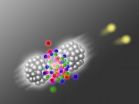(Press-News.org) COLUMBUS, Ohio – A hormone-like substance produced by the body to promote inflammation can cause an aggressive form of leukemia when present at high levels, according to a new study by researchers at the Ohio State University Comprehensive Cancer Center – Arthur G. James Cancer Hospital and Richard J. Solove Research Institute (OSUCCC – James).
The study shows that high levels of interleukin-15 (IL-15) alone can cause large granular lymphocytic (LGL) leukemia, a rare and usually fatal form of cancer, in an animal model. The researchers also developed a treatment for the leukemia that showed no discernible side effects in the animal model.
Published in the journal Cancer Cell, the findings show that IL-15 is also overexpressed in patients with LGL leukemia and that it causes similar cellular changes, suggesting that the treatment should also benefit people with the malignancy.
"We know that inflammation can cause cancer, but we don't know the exact mechanism," says principal investigator Dr. Michael A. Caligiuri, CEO of The James Cancer Hospital and Solove Research Institute, and director of Ohio State's Comprehensive Cancer Center.
"Here, we show one way it can happen, and we used that information to potentially cure the cancer."
Normally, the body releases IL-15 to stimulate the development, survival and proliferation of natural-killer cells, which are immune cells that destroy cancer and virus-infected cells. This research shows that when IL-15 is present in high amounts in the body for prolonged periods, such as during chronic inflammation, it can cause certain immune cells called large granular lymphocytes, or LGLs, to become cancerous.
This malignant transformation begins when IL-15 attaches to receptors on the surface of normal LGLs, an event that boosts levels of a cancer-causing protein called Myc (pronounced "mick") inside the cells. The high Myc levels, in turn, bring changes that cause chromosome instability and additional gene mutations. The high Myc levels also activate a process called DNA methylation, which turns off a variety of genes, including important genes that normally suppress cancer growth.
"We stand the best chance of curing cancer when we understand its causes," says first author Anjali Mishra, a postdoctoral researcher in Caligiuri's laboratory. "Once we understood how this inflammatory hormone causes this leukemia, we used that information to develop a treatment by interfering with the process."
Caligiuri and Mishra were joined in this study by Dr. Guido Marcucci, associate director for Translational Research at the OSUCCC – James, Dr. Robert Lee, professor of pharmaceutics and pharmaceutical chemistry in Ohio State's College of Pharmacy and a group of collaborators. The investigators conducted the research using cells isolated from patients with LGL leukemia and a mouse model of the disease. Key findings include:
Exposing normal, human, large granular lymphocytes to IL-15 caused cell proliferation, chromosomal instability and global DNA hypermethylation;
Excessive IL-15 activated the cancer-causing Myc oncogene in large granular lymphocytes, leading to genetic instability, DNA hypermethylation and malignant transformation;
Details of how Myc upregulation causes the genetic instability and hypermethylation.
Lee developed a liposomal formulation of the proteosome inhibitor bortezomib that shuts down the cancer-causing pathway, potentially curing the malignancy. Leukemic mice treated with the liposomal bortezomib showed 100 percent survival at 130 days versus 100 percent mortality at 60-80 days for control animals.
"We now plan to develop this drug for clinical use," says Marcucci, who holds the John B. and Jane T. McCoy Chair in Cancer Research in Cancer Research.
###
Other Ohio State researchers involved in this study were Shujun Liu, Gregory H. Sams, Douglas P. Curphey, Ramasamy Santhanam, Laura J. Rush, Deanna Schaefer, Lauren G. Falkenberg, Laura Sullivan, Laura Jaroncyk, Xiaojuan Yang, Harold Fisk, Lai-Chu Wu, Christopher Hickey, Jason C. Chandler, Yue-Zhong Wu, Nyla A. Heerema, Kenneth K. Chan, Danilo Perrotti, Jianying Zhang, Pierluigi Porcu, Frederick K. Racke and Ramiro Garzon.
The Ohio State University Comprehensive Cancer Center – Arthur G. James Cancer Hospital and Richard J. Solove Research Institute strives to create a cancer-free world by integrating scientific research with excellence in education and patient-centered care, a strategy that leads to better methods of prevention, detection and treatment. Ohio State is one of only 41 National Cancer Institute (NCI)-designated Comprehensive Cancer Centers and one of only seven centers funded by the NCI to conduct both phase I and phase II clinical trials. The NCI recently rated Ohio State's cancer program as "exceptional," the highest rating given by NCI survey teams. As the cancer program's 210-bed adult patient-care component, The James is a "Top Hospital" as named by the Leapfrog Group and one of the top cancer hospitals in the nation as ranked by
U.S.News & World Report.
Home field advantage: Intravaginal immunization may help protect against infection
Sexually-transmitted diseases (STDs) enter the body through the mucosal epithelial cells and the ability to direct pathogen-clearing T-cells to points of infection may be the critical element in developing successful vaccines against these infections. In a study published in the Journal of Clinical Investigation, researchers led by John Schiller at the National Cancer Institute investigated the immune response to intravaginal immunization in mice infected with a form of the HPV virus carrying ...
Sexually-transmitted diseases (STDs) enter the body through the mucosal epithelial cells and the ability to direct pathogen-clearing T-cells to points of infection may be the critical element in developing successful vaccines against these infections. In a study published in the Journal of Clinical Investigation, researchers led by John Schiller at the National Cancer Institute investigated the immune response to intravaginal immunization in mice infected with a form of the HPV virus carrying a model antigen. They found that intravaginal immunization significantly increased ...
HIV-1 is a genetically diverse collection of viruses, making it a moving target in vaccine development. In a study published in the Journal of Clinical Investigation, researchers led by Brad Jones at the University of Toronto in investigated the feasibility of eliminating HIV-infected cells by targeting cellular immune responses against a human endogenous retrovirus (HERV). HERVs are the DNA remnants of ancient infectious retroviruses that became part of the germ line cells of our ancestors. Jones and colleagues found that HIV infection stimulated the expression of HERV ...
CHICAGO – November 12, 2012 – A new study provides the first clear evidence that vision or eye problems are rarely the cause of recurring headaches in children, even if the headaches usually strike while the child is doing schoolwork or other visual tasks. Many parents assume that frequent headaches mean their child needs glasses, so they ask their doctor to refer their child for an eye exam. This study was conducted by pediatric ophthalmologists who wanted to find reliable answers for parents, family doctors and pediatricians facing this common health question. The research ...
CHICAGO – November 12, 2012 – New research shows that the use of an audio therapy known as binaural beats can significantly reduce patients' anxiety during cataract surgery. The 141-patient study, conducted in Thailand, is the first of its kind in cataract surgery, which is one of the most frequently performed procedures worldwide, with more than 3 million performed annually in the United States. The research is being presented today at the 116th Annual Meeting of the American Academy of Ophthalmology, jointly conducted this year with the Asia-Pacific Academy of Ophthalmology. ...
Los Angeles, CA (November 12, 2012) Veterans are becoming more geographically isolated as they migrate to smaller, more rural counties surrounding military bases finds a recent article in Armed Forces & Society, a SAGE journal published on behalf of the Inter-University Seminar on Armed Forces and Society.
Using the 1980, 1990, and 2010 censuses, study author Jay Teachman examined population data from 3131 US counties. He found that the areas to which veterans migrate are becoming more veteran-concentrated which has led to a segregation of Americans between veteran and ...
Heavy ion collisions at CERN should be able to produce the shortest light pulses ever created. This was demonstrated by computer simulations at the Vienna University of Technology. The pulses are so short that they cannot even be measured by today's technological equipment. Now, a method has been proposed to create the world's most precise stopwatch for the world's shortest light pulses, using a detector which is going to be installed at CERN in 2018.
Small, Short and Hot
Phenomena taking place on very short time scales are often investigated using ultra short laser ...
Human intelligence and behavior require optimal functioning of a large number of genes, which requires enormous evolutionary pressures to maintain. A provocative hypothesis published in a recent set of Science and Society pieces published in the Cell Press journal Trends in Genetics suggests that we are losing our intellectual and emotional capabilities because the intricate web of genes endowing us with our brain power is particularly susceptible to mutations and that these mutations are not being selected against in our modern society.
"The development of our intellectual ...
DEVOTES stands for "DEVelopment Of innovative Tools for understanding marine biodiversity and assessing good Environmental Status". DEVOTES is a four year project, which has a total budget of € 12 million, of which €9 million are funded by the 7th Framework Programme of the European Union. DEVOTES is coordinated by Ángel Borja, from AZTI-Tecnalia, a Spanish technological centre, specialized in marine and food research.
More than 250 scientists, from 23 research centres of 12 European Union countries, as well as Ukraine, Turkey, Saudi Arabia and USA, will work in DEVOTES ...
Have you ever thought to use a clock to identify mineral deposits or concealed water resources within the Earth? An international team headed by astrophysicists Philippe Jetzer and Ruxandra Bondarescu from the University of Zurich is convinced that ultraprecise portable atomic clocks will make this a reality in the next decade. The scientists argue that these atomic clocks have already reached the necessary degree of precision to be useful for geophysical surveying. They say that such clocks will provide the most direct measurement of the geoid – the Earth's true physical ...



